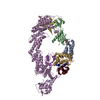+ Open data
Open data
- Basic information
Basic information
| Entry | Database: PDB / ID: 8rwz | |||||||||||||||
|---|---|---|---|---|---|---|---|---|---|---|---|---|---|---|---|---|
| Title | Open non-crosslinked structure Brd4BD2-MZ1-(NEDD8)-CRL2VHL | |||||||||||||||
 Components Components |
| |||||||||||||||
 Keywords Keywords | LIGASE / BET bromodomain / E3 ligase / PROTAC | |||||||||||||||
| Function / homology |  Function and homology information Function and homology informationregulation of cellular response to hypoxia / cullin-RING-type E3 NEDD8 transferase / NEDD8 transferase activity / cullin-RING ubiquitin ligase complex / negative regulation of receptor signaling pathway via JAK-STAT / RHOBTB3 ATPase cycle / Cul7-RING ubiquitin ligase complex / ubiquitin-dependent protein catabolic process via the C-end degron rule pathway / cellular response to chemical stress / Loss of Function of FBXW7 in Cancer and NOTCH1 Signaling ...regulation of cellular response to hypoxia / cullin-RING-type E3 NEDD8 transferase / NEDD8 transferase activity / cullin-RING ubiquitin ligase complex / negative regulation of receptor signaling pathway via JAK-STAT / RHOBTB3 ATPase cycle / Cul7-RING ubiquitin ligase complex / ubiquitin-dependent protein catabolic process via the C-end degron rule pathway / cellular response to chemical stress / Loss of Function of FBXW7 in Cancer and NOTCH1 Signaling / transcription elongation factor activity / target-directed miRNA degradation / elongin complex / positive regulation of protein autoubiquitination / RNA polymerase II transcription initiation surveillance / protein neddylation / Replication of the SARS-CoV-1 genome / NEDD8 ligase activity / negative regulation of response to oxidative stress / VCB complex / Cul5-RING ubiquitin ligase complex / SCF ubiquitin ligase complex / negative regulation of type I interferon production / ubiquitin-ubiquitin ligase activity / intracellular membraneless organelle / SCF-dependent proteasomal ubiquitin-dependent protein catabolic process / Cul2-RING ubiquitin ligase complex / Cul3-RING ubiquitin ligase complex / Cul4A-RING E3 ubiquitin ligase complex / Cul4-RING E3 ubiquitin ligase complex / SUMOylation of ubiquitinylation proteins / negative regulation of mitophagy / Prolactin receptor signaling / Cul4B-RING E3 ubiquitin ligase complex / ubiquitin ligase complex scaffold activity / RNA polymerase II C-terminal domain binding / P-TEFb complex binding / negative regulation of DNA damage checkpoint / histone H4 reader activity / cullin family protein binding / negative regulation of transcription elongation by RNA polymerase II / Pausing and recovery of Tat-mediated HIV elongation / Tat-mediated HIV elongation arrest and recovery / HIV elongation arrest and recovery / Pausing and recovery of HIV elongation / host-mediated suppression of viral transcription / protein monoubiquitination / positive regulation of G2/M transition of mitotic cell cycle / negative regulation of signal transduction / positive regulation of T-helper 17 cell lineage commitment / Tat-mediated elongation of the HIV-1 transcript / Formation of HIV-1 elongation complex containing HIV-1 Tat / ubiquitin-like ligase-substrate adaptor activity / protein K48-linked ubiquitination / Formation of HIV elongation complex in the absence of HIV Tat / Nuclear events stimulated by ALK signaling in cancer / RNA Polymerase II Transcription Elongation / Formation of RNA Pol II elongation complex / : / negative regulation of TORC1 signaling / transcription-coupled nucleotide-excision repair / RNA Polymerase II Pre-transcription Events / positive regulation of TORC1 signaling / regulation of cellular response to insulin stimulus / RNA polymerase II CTD heptapeptide repeat kinase activity / negative regulation of insulin receptor signaling pathway / intrinsic apoptotic signaling pathway / protein serine/threonine kinase binding / negative regulation of autophagy / post-translational protein modification / T cell activation / Regulation of BACH1 activity / transcription corepressor binding / condensed nuclear chromosome / transcription coregulator activity / TP53 Regulates Transcription of DNA Repair Genes / cellular response to amino acid stimulus / positive regulation of cell differentiation / transcription initiation at RNA polymerase II promoter / Degradation of DVL / transcription elongation by RNA polymerase II / positive regulation of transcription elongation by RNA polymerase II / Degradation of GLI1 by the proteasome / GSK3B and BTRC:CUL1-mediated-degradation of NFE2L2 / Negative regulation of NOTCH4 signaling / G1/S transition of mitotic cell cycle / Recognition of DNA damage by PCNA-containing replication complex / negative regulation of canonical Wnt signaling pathway / Hedgehog 'on' state / Vif-mediated degradation of APOBEC3G / FBXL7 down-regulates AURKA during mitotic entry and in early mitosis / Degradation of GLI2 by the proteasome / GLI3 is processed to GLI3R by the proteasome / RING-type E3 ubiquitin transferase / Inactivation of CSF3 (G-CSF) signaling / Degradation of beta-catenin by the destruction complex / DNA Damage Recognition in GG-NER / Oxygen-dependent proline hydroxylation of Hypoxia-inducible Factor Alpha / Evasion by RSV of host interferon responses / NOTCH1 Intracellular Domain Regulates Transcription Similarity search - Function | |||||||||||||||
| Biological species |  Homo sapiens (human) Homo sapiens (human) | |||||||||||||||
| Method | ELECTRON MICROSCOPY / single particle reconstruction / cryo EM / Resolution: 4 Å | |||||||||||||||
 Authors Authors | Crowe, C. / Nakasone, M.A. / Ciulli, A. | |||||||||||||||
| Funding support | European Union,  United Kingdom, United Kingdom,  Switzerland, 4items Switzerland, 4items
| |||||||||||||||
 Citation Citation |  Journal: Sci Adv / Year: 2024 Journal: Sci Adv / Year: 2024Title: Mechanism of degrader-targeted protein ubiquitinability. Authors: Charlotte Crowe / Mark A Nakasone / Sarah Chandler / Conner Craigon / Gajanan Sathe / Michael H Tatham / Nikolai Makukhin / Ronald T Hay / Alessio Ciulli /  Abstract: Small-molecule degraders of disease-driving proteins offer a clinically proven modality with enhanced therapeutic efficacy and potential to tackle previously undrugged targets. Stable and long-lived ...Small-molecule degraders of disease-driving proteins offer a clinically proven modality with enhanced therapeutic efficacy and potential to tackle previously undrugged targets. Stable and long-lived degrader-mediated ternary complexes drive fast and profound target degradation; however, the mechanisms by which they affect target ubiquitination remain elusive. Here, we show cryo-EM structures of the VHL Cullin 2 RING E3 ligase with the degrader MZ1 directing target protein Brd4 toward UBE2R1-ubiquitin, and Lys at optimal positioning for nucleophilic attack. In vitro ubiquitination and mass spectrometry illuminate a patch of favorably ubiquitinable lysines on one face of Brd4, with cellular degradation and ubiquitinomics confirming the importance of Lys and nearby Lys/Lys, identifying the "ubiquitination zone." Our results demonstrate the proficiency of MZ1 in positioning the substrate for catalysis, the favorability of Brd4 for ubiquitination by UBE2R1, and the flexibility of CRL2 for capturing suboptimal lysines. We propose a model for ubiquitinability of degrader-recruited targets, providing a mechanistic blueprint for further rational drug design. #1:  Journal: Biorxiv / Year: 2024 Journal: Biorxiv / Year: 2024Title: Mechanism of degrader-targeted protein ubiquitinability Authors: Crowe, C. / Nakasone, M.A. / Chandler, S. / Tatham, M.H. / Makukhin, N. / Hay, R.T. / Ciulli, A. | |||||||||||||||
| History |
|
- Structure visualization
Structure visualization
| Structure viewer | Molecule:  Molmil Molmil Jmol/JSmol Jmol/JSmol |
|---|
- Downloads & links
Downloads & links
- Download
Download
| PDBx/mmCIF format |  8rwz.cif.gz 8rwz.cif.gz | 215.4 KB | Display |  PDBx/mmCIF format PDBx/mmCIF format |
|---|---|---|---|---|
| PDB format |  pdb8rwz.ent.gz pdb8rwz.ent.gz | 142.2 KB | Display |  PDB format PDB format |
| PDBx/mmJSON format |  8rwz.json.gz 8rwz.json.gz | Tree view |  PDBx/mmJSON format PDBx/mmJSON format | |
| Others |  Other downloads Other downloads |
-Validation report
| Summary document |  8rwz_validation.pdf.gz 8rwz_validation.pdf.gz | 1.3 MB | Display |  wwPDB validaton report wwPDB validaton report |
|---|---|---|---|---|
| Full document |  8rwz_full_validation.pdf.gz 8rwz_full_validation.pdf.gz | 1.4 MB | Display | |
| Data in XML |  8rwz_validation.xml.gz 8rwz_validation.xml.gz | 42.9 KB | Display | |
| Data in CIF |  8rwz_validation.cif.gz 8rwz_validation.cif.gz | 64.4 KB | Display | |
| Arichive directory |  https://data.pdbj.org/pub/pdb/validation_reports/rw/8rwz https://data.pdbj.org/pub/pdb/validation_reports/rw/8rwz ftp://data.pdbj.org/pub/pdb/validation_reports/rw/8rwz ftp://data.pdbj.org/pub/pdb/validation_reports/rw/8rwz | HTTPS FTP |
-Related structure data
| Related structure data |  19569MC  8rx0C M: map data used to model this data C: citing same article ( |
|---|---|
| Similar structure data | Similarity search - Function & homology  F&H Search F&H Search |
- Links
Links
- Assembly
Assembly
| Deposited unit | 
|
|---|---|
| 1 |
|
- Components
Components
-Protein , 6 types, 6 molecules ABCDER
| #1: Protein | Mass: 13281.371 Da / Num. of mol.: 1 Source method: isolated from a genetically manipulated source Source: (gene. exp.)  Homo sapiens (human) / Gene: BRD4, HUNK1 / Production host: Homo sapiens (human) / Gene: BRD4, HUNK1 / Production host:  |
|---|---|
| #2: Protein | Mass: 18558.162 Da / Num. of mol.: 1 Source method: isolated from a genetically manipulated source Source: (gene. exp.)  Homo sapiens (human) / Gene: VHL / Production host: Homo sapiens (human) / Gene: VHL / Production host:  |
| #3: Protein | Mass: 11748.406 Da / Num. of mol.: 1 Source method: isolated from a genetically manipulated source Source: (gene. exp.)  Homo sapiens (human) / Gene: ELOB, TCEB2 / Production host: Homo sapiens (human) / Gene: ELOB, TCEB2 / Production host:  |
| #4: Protein | Mass: 10914.498 Da / Num. of mol.: 1 Source method: isolated from a genetically manipulated source Source: (gene. exp.)  Homo sapiens (human) / Production host: Homo sapiens (human) / Production host:  |
| #5: Protein | Mass: 87098.930 Da / Num. of mol.: 1 Source method: isolated from a genetically manipulated source Source: (gene. exp.)  Homo sapiens (human) / Gene: CUL2 / Production host: Homo sapiens (human) / Gene: CUL2 / Production host:  |
| #6: Protein | Mass: 11196.830 Da / Num. of mol.: 1 Source method: isolated from a genetically manipulated source Source: (gene. exp.)  Homo sapiens (human) / Gene: RBX1, RNF75, ROC1 / Production host: Homo sapiens (human) / Gene: RBX1, RNF75, ROC1 / Production host:  |
-Non-polymers , 2 types, 4 molecules 


| #7: Chemical | ChemComp-759 / ( |
|---|---|
| #8: Chemical |
-Details
| Has ligand of interest | Y |
|---|---|
| Has protein modification | N |
-Experimental details
-Experiment
| Experiment | Method: ELECTRON MICROSCOPY |
|---|---|
| EM experiment | Aggregation state: PARTICLE / 3D reconstruction method: single particle reconstruction |
- Sample preparation
Sample preparation
| Component | Name: Open non-crosslinked structure Brd4BD2-MZ1-(NEDD8)-CRL2VHL Type: COMPLEX / Entity ID: #1-#6 / Source: RECOMBINANT |
|---|---|
| Molecular weight | Value: 0.19 MDa / Experimental value: NO |
| Source (natural) | Organism:  Homo sapiens (human) Homo sapiens (human) |
| Source (recombinant) | Organism:  |
| Buffer solution | pH: 7.8 |
| Specimen | Embedding applied: NO / Shadowing applied: NO / Staining applied: NO / Vitrification applied: YES |
| Vitrification | Cryogen name: ETHANE |
- Electron microscopy imaging
Electron microscopy imaging
| Microscopy | Model: TFS GLACIOS |
|---|---|
| Electron gun | Electron source:  FIELD EMISSION GUN / Accelerating voltage: 200 kV / Illumination mode: FLOOD BEAM FIELD EMISSION GUN / Accelerating voltage: 200 kV / Illumination mode: FLOOD BEAM |
| Electron lens | Mode: BRIGHT FIELD / Nominal defocus max: 3200 nm / Nominal defocus min: 1700 nm |
| Image recording | Electron dose: 26 e/Å2 / Film or detector model: TFS FALCON 4i (4k x 4k) |
- Processing
Processing
| EM software | Name: PHENIX / Version: 1.21.1_5286: / Category: model refinement | ||||||||||||||||||||||||
|---|---|---|---|---|---|---|---|---|---|---|---|---|---|---|---|---|---|---|---|---|---|---|---|---|---|
| CTF correction | Type: PHASE FLIPPING AND AMPLITUDE CORRECTION | ||||||||||||||||||||||||
| 3D reconstruction | Resolution: 4 Å / Resolution method: FSC 0.143 CUT-OFF / Num. of particles: 132697 / Symmetry type: POINT | ||||||||||||||||||||||||
| Refine LS restraints |
|
 Movie
Movie Controller
Controller




 PDBj
PDBj


















